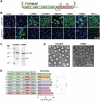Synthetic recovery of Yada Yada virus expands insect-specific alphavirus knowledge and facilitates production of chimeric viruses
- PMID: 40295870
- PMCID: PMC11721364
- DOI: 10.1038/s44298-024-00052-2
Synthetic recovery of Yada Yada virus expands insect-specific alphavirus knowledge and facilitates production of chimeric viruses
Erratum in
-
Publisher Correction: Npj Viruses, volume 2, missing Data Availability statements.Npj Viruses. 2025 Mar 5;3(1):18. doi: 10.1038/s44298-025-00094-0. Npj Viruses. 2025. PMID: 40295891 Free PMC article. No abstract available.
Abstract
Few insect-specific alphaviruses (ISA) have been discovered, with even fewer culturable to facilitate full characterisation. Here, we report the recovery of an infectious clone of Yada Yada virus (YYV)-a virus previously only detected by metagenomic sequencing of mosquito homogenates. Using the infectious clone, we confirmed the inability of YYV to replicate in vertebrate cells in vitro, with replication limited to only Aedes mosquito-derived cell lines. We further produced and characterised the first monoclonal antibodies (mAbs) to ISAs. Through successful replacement of the structural proteins of YYV with those of other ISAs, Eilat virus, Agua Salud (ASALV), Taï Forest (TALV) and Mwinilunga alphaviruses (MWAV), we established that a replication block for in vitro culture of TALV and MWAV in mosquito cells does not exist at virus entry. Unexpectedly, ASALV structural proteins were recognised by cross-reactive mAbs made to chikungunya (CHIKV) and Ross River viruses (RRV), suggesting a potential antigenic link between ASALV and pathogenic alphaviruses. The YYV genetic backbone was also investigated to generate chimeras displaying the structural proteins of various pathogenic vertebrate-infecting alphaviruses including CHIKV, RRV, Barmah Forest, Sindbis and Mayaro viruses. These chimeras retained the antigenic properties of the parental viruses and did not replicate in vertebrate cells, demonstrating the potential of the YYV platform for vaccine and diagnostic antigen production.
© 2024. The Author(s).
Conflict of interest statement
Competing interests: The authors declare no competing interests.
Figures



References
-
- Chen, R. et al. ICTV virus taxonomy profile: Togaviridae. J Gen Virol99, 761–762 (2018). - PubMed
-
- Zaid, A. et al. Arthritogenic alphaviruses: epidemiological and clinical perspective on emerging arboviruses. Lancet Infect. Dis.21, e123–e133 (2021). - PubMed
-
- Howley, P. M., Knipe, D. M. & Whelan, S. Fields Virology: Emerging Viruses. 7th ed edn (Lippincott Williams & Wilkins, 2021).
Grants and funding
LinkOut - more resources
Full Text Sources

